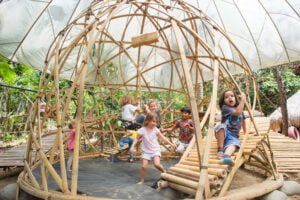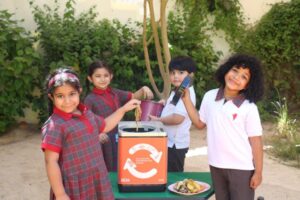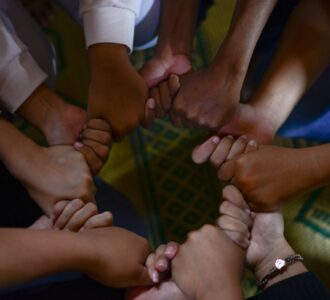In the wake of world leaders’ failure at COP27, the next generation will play an increasingly important role in tackling climate change. Salman Shaheen finds out how schools are preparing them to face the future.
Despite the historic agreement on a Loss and Damage Fund, COP27 will be remembered as a failure. Governments fundamentally did not commit to phase out fossil fuels. With world leaders steering the planet ever closer to the 1.5°C cliff edge, it is becoming increasingly obvious that it is the next generation who will have to pick up the pieces. Teaching them to become active citizens in the fight against ecological disaster, then, will become a core function of schools. Worryingly, a new UNESCO report launched during COP27 found that 70% of young people question the quality of the Climate Change Education they receive. Some schools, however, have made tackling climate change part of their very being and it is having a huge impact on children’s outlook. Their students are not only prepared to face the future, but to change it.
Why schools need to embed Climate Change Education
As David Mitchell, headteacher of Dunoon Grammar School in Scotland, UK, puts it: “For too long, too many well-meaning people have proposed vague actions to the climate crisis. Mother nature has been chapping on our doors – the floods, the droughts, the fires – but we have not yet got our own sleeves fully rolled up and taken the action required. That is one area our young people can educate us on. They are not just the future, but the here and now – able and willing to make a difference.”
Green School Bali in Indonesia’s trailblazing work frequently sees it represented at COP. For Sal Gordon, Head of Teaching and Learning, the importance of weaving Climate Change Education into the fabric of schools for the world to tackle environmental disaster cannot be overstated.
“The rapid pace of innovation, and the rapid changes to our climate occurring this century both present massive threats to our largely outdated education system,” Gordon says. He points out that schools as physical locations are threatened by severe weather events. For many children, these events also threaten their access to education when communities are displaced and school buildings left in ruins. Research is also showing how air pollution is having negative impacts on early childhood brain development.
“In other words, schools and their communities are on the front lines. But they are also part of the solution. It is essential now more than ever that we are preparing students with the knowledge, skills and values to tackle today’s increasingly complex social and environmental challenges in order to make the world a better place. At Green School Bali environmental action is the foundational purpose of our school – educating for, not just about, sustainability – and our learning programmes are designed with environmental action embedded across the experience.”
For more on Green School Bali’s method, download its School Transformation Toolkit
Last month, Bonuan Buquig National High School in the Philippines won the World’s Best School Prize for Environmental Action for its inspirational project that galvanised students to restore lost mangroves. Few people understand the importance of embedding environmental education more than principal Renato Santillan.
“If the young are properly educated and well-informed, the small step would create a ripple effect as they share information with their families and friends,” he says. “Moreover, the good habit and discipline that they practice at school would be brought to each household and in the community.”
Another leader in the field is GEMS Legacy School in the UAE, which became the first in the world to have a United Nations certified Climate Change teacher in every one of its 162 classrooms, with all 300-plus teaching and administration staff at the school, along with 60 parents, completing the UNCC: Learn course – raising awareness among students about climate change. Principal and CEO Asha Alexander says prioritising climate education demonstrates how students’ everyday actions — whether it’s what they eat or how they get to school – impact the natural world.
“Teaching empathy among students is another fundamental outcome when climate literacy is embedded as an inherent part of the curricula. In doing so, students will recognise how society’s collective actions impact individuals and understand the plight of others,” she says. “This can build emotional connections which ultimately drive action.”
How schools are embedding Climate Change Education
Teaching empathy and responsibility are key themes for the schools that are successfully embedding Climate Change Education. Schools may inherently act local, but they have to think global. For Green School Bali, this is crucial, alongside solution-focused, project-based learning that imparts skills such as communication, collaboration, critical thinking, creative problem solving, resilience, adaptability and being able to think in systems. All of this is taught through the lens of sustainability.

Gordon says an education at Green School is co-created between students and their teachers. “We believe in developing a new kind of IQ – Intelligent Questioning – and encouraging students to actively pursue the questions they have about the things that interest them the most. Our systems-thinking focus on sustainability – understanding there are nature-based, economic, societal and wellbeing factors – provides a medium for our whole community to be connected to the natural environment and to be changemakers for a better future. From there, teachers are able to integrate more traditional areas of study, such as Math, Science, Art, Literacy, etc, into the projects students decide to pursue.”
For Alexander, it’s important that education on sustainability is as action oriented as it is theoretical – every subject has been embedded with lessons on climate change and the Sustainable Development Goals. This helps students to see the bigger picture of the causes of climate change and the contribution they make personally.
“Specifically, incorporating the STEAM subjects into lessons and launching projects within robotics and artificial intelligence classes nudge students to use design thinking to devise and apply solutions to climate challenges,” Alexander says. “Here we’re creating a bridge to industry and students’ eventual careers by introducing them to a real-world challenge and asking them to lead on a solution using advanced technology, just as they’ll need to do in 10- or 20-years’ time during their careers.”
For more on GEMS LEGACY’S method, download its School Transformation Toolkit

At Dunoon Grammar School, Climate Change Education goes far beyond Science students learning about how humans have disrupted the natural carbon cycle. Its Languages department has students utilising resources from the Museo del Prado in Madrid – exploring how the landscape in famous paintings will change if the world doesn’t act. In Food and Health Technology classes young people examine how climate change is affecting crop production, global food supply chains, food prices and nutritional wellbeing. Students learn to recycle and compost. They are taught to avoid waste and work with food economically. They have adapted recipes to be climate conscious. They are growing food from wheat to tomatoes, herbs and potatoes to use in practical cooking.
Meanwhile, students in the school’s Learning Centre – which provides for learners with additional support needs – have written to world leaders encouraging them to take action and they made a short film to educate the wider school community about climate change. They have also been working with community partners to produce a green map of sustainable living, nature, culture and society around the town and visited a local forest to learn about sustainable forestry practice.
“Climate education is not a bolt on, but truly embedded in our day-to-day learning and teaching,” says Mitchell. “Our efforts are not only about raising awareness and knowledge on the issues, but to provide opportunities for pupil-led action where our young people can be proactive agents of positive change. This is exemplified with our young people working on a pioneering pilot course called Climate Action, in conjunction with our good friends Apps for Good – a charity that promotes the teaching of Computing Science across the Globe.”
When COP26 was held in Glasgow last year, students had the perfect opportunity right on their doorstep to get stuck into coding apps to address climate change.
“Our young people are generating ideas for technological solutions to the climate crisis and coding proof of concept prototypes – including Internet of Things and Machine Learning solutions. This active, experiential learning not only helps with their understanding of the causes of the climate crisis but provides a forum to prove that they can be the agents of change and that they can be the difference and a force for good.”

Mitchell points out active, experiential learning allows for deeper more meaningful learning experiences for our young people. “Our teaching staff are less the sage on the stage and now more of a guide by the side of our learners as they lead a range of projects – developing essential skills for learning, life and work.”
For more on Dunoon Grammar School’s method, download its School Transformation Toolkit
Impact
By embedding Climate Change Education into the curriculum, Alexander says students at GEMS Legacy have adopted self-reflection, self-determination, and other soft skills that underpin personal behaviour change.
As learners become more educated in light of climate change, they become more active in activities devoted to environmental actions, Santillan points out. “Our learners develop that sense of responsibility as they join clubs and organisations promoting awareness and addressing climate change. It is important that they understand what they are fighting for, and why they do this endeavour. In this way, they are more motivated to do the action and simply discipline themselves to avoid the human activities that contribute to climate change.”

“Our young people are not only more informed on the causes of climate action, but what has to change to address this critical issue,” Mitchell says. “They recognise they can be role models in taking better care of the environment – from reducing food wastage, to recycling, to reducing plastic use to innovating ground-breaking digital solutions. An Eco Committee has been established to regularly challenge our school and wider community to take care of their local, national and global environments.”
The much larger task, though, will be challenging the actions, or inaction, of governments. A consensus is rapidly emerging that world leaders dropped the ball at COP27. If the next generation is to pick it up, then it is schools that will equip them with the tools to do so. Not just the knowledge and the skills, but the mindset. As with so much else, it is teachers who hold the future in their hands.



